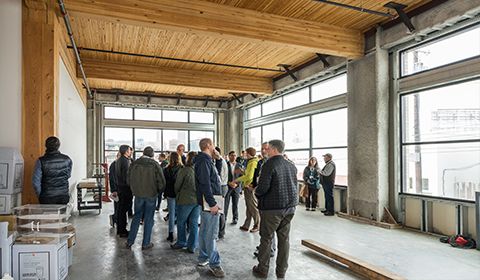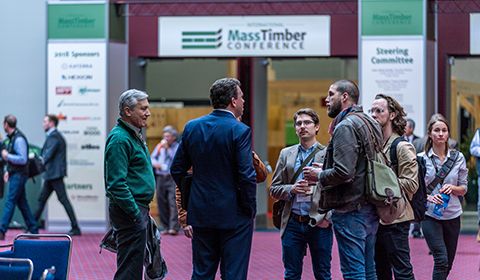The NEXT Lab (2024)

NEXT IS A PLATFORM THAT ALLOWS TENANTS AND DEVELOPERS TO REIMAGINE A MORE RESILIENT AND INCLUSIVE SCIENCE BUILDING.
Source: Gensler
Project Owner: Gensler
Project Location: Seattle, Washington
Completion Date: January 15, 2022
Architect/Designer: Chad Yoshinobu (and Broader Gensler Team)
Structural Engineer: KPFF
Mechanical, Electrical, and Plumbing: Buro Happold
IN A FAST GROWING market, increased competition among science building developers is driving the demand for lab spaces and science workplaces, challenging the status quo to create different spaces for tenants. Gensler identified an opportunity to develop a conceptual design that reimagines the life science workplace. Gensler’s Science Practice Area team conducted a research project funded by the Gensler Research Institute in partnership with structural engineers at KPFF and mechanical, engineering, and plumbing (MEP) engineers at Buro Happold. The study measured the impact of a mass timber science building on tenants, the environment, and the community by prioritizing performance flexibility, market differentiation, climate readiness, and well-being.

LEFT — WITH A MULTITUDE OF OPERABLE WINDOWS AND OUTDOOR SPACES, THE WORKPLACE PORTION OF THE FLOOR WILL HAVE ABUNDANT ACCESS TO FRESH AIR.
RIGHT — FLIPPING THE FIRE STAIR TO THE PERIMETER NOT ONLY FLOODS IT WITH DAYLIGHT AND AMENABLE VIEWS BUT ALSO TRANSFORMS IT INTO A MULTIUSE TENANT AMENITY.
Source: Gensler
Gensler named its 250,000-square-foot conceptual lab building NEXT and put it in Seattle’s Uptown Arts District. NEXT represents a point of differentiation, reinventing what a lab is, from a sustainable, aesthetic, functional, and optimized perspective. Designed with an offset core, NEXT provides maximum tenant flexibility for the lab/ workplace at 33 by 33 feet. Although a mass timber structure grid of this size doesn’t work well for vibration, Gensler partnered with KPFF to achieve the industry-standard vibration of 6,000 MIPS .
Health and wellness for tenants and visitors alike is integral to the NEXT design. The shift of core components provides every floor access to outdoor space. NEXT also provides natural ventilation through operable windows, and it was designed so that the workplace portion of the floor can spend 34 percent of occupied hours in natural ventilation mode. And NEXT is designed to be a community catalyst by creating opportunities for public programs on the ground floor, including opportunities to host a multipurpose arts and entertainment venue and a shared incubation restaurant/kitchen space.
NEXT delivers a resilient building in a shorter speed-to-market time. Mass timber is particularly suited to off-site construction; it can be produced in a nearby factory and delivered to the site as a kit-ofparts, resulting in a 30 percent faster build time and 10 percent in cost savings compared with construction of a typical concrete building. With 85 percent fewer deliveries to the site and 75 percent less construction waste, NEXT uses 80 percent less carbon to build than a conventional concrete lab building. This amounts to a savings of approximately 5,200 total metric tons of carbon dioxide (CO2).
Gensler extended the sustainable approach to the building’s operations. NEXT uses an all-electric heat pump chiller (EL1) system that results in lower building EUI in all markets and achieves zero-carbon emissions on a clean grid. In total, NEXT produces 50 percent fewer greenhouse gas emissions and uses 30 percent less energy annually than a conventional lab building.Through a multifaceted design approach, Gensler demonstrates how a science building can be reimagined to foster renewed investment in urban cores and facilitate a human-centric return to office movement.
Download PDF
 View the Agenda
View the Agenda
 Book a Building Tour
Book a Building Tour
 Book Your Exhibit Space
Book Your Exhibit Space
 Explore the Exhibit Hall
Explore the Exhibit Hall
 Become a Sponsor Today
Become a Sponsor Today
 View Sponsors & Partners
View Sponsors & Partners
 Call for Content
Call for Content
 Purchase Report
Purchase Report